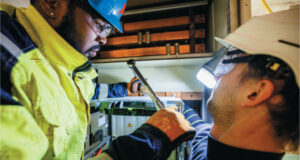TOR IDHAMMAR
Is it just me who thinks that improvement projects have gotten more complicated than necessary? I mean to a point where implementation becomes impossible and projects fizzle out completely, sometimes after thousands of work hours have been put in.
Keeping things simple when you implement maintenance processes is the foundation for successful execution on the plant floor. This is the best possible scenario to reach your goals.
At a paper mill some years ago, I held a training course in how to efficiently document and implement preventive maintenance. Afterward, the participants said they felt they already knew a lot of what I had touched upon in the course. Unfortunately, they probably meant they knew the theoretical part—how to approach documentation of PM—but less about the actual implementation. Later, as it turned out, they proved that they may have understood the concepts, but managed neither.
The participants at that paper mill were totally on board with the documentation piece; they understood the theory, or so they said. But after the course was over, the end goal was changed—mostly because they didn’t know how to implement a PM project, but also due to old habits. The goal went from implementing PM efficiently to documenting PM (efficiency disappeared.) Unfortunately, this phenomenon is extremely common.
Many technically minded people focus on documenting specifications for how work is supposed to be carried out. They commonly assume that others execute what they document, but they seldom (or never) take responsibility for implementing the documentation they have created. In my experience, documentation should be approximately five percent of the improvement work, while 95 percent of the work is about convincing humans to follow a specification on the floor or buy in to the project.
Maintenance projects usually demand 5 percent for documentation and/or design of processes, about 10 percent for informing and training the personnel on how the documentation works, and 85 percent for coaching and follow-up with those who are carrying out the maintenance project, whatever it may be. And that’s exactly why IDCON’s consultants spend 80-90 percent of their time in plants, mines, and mills and only 10-20 percent teaching courses.
IMPLEMENTATION STAGNATION
Two years later, I did a follow-up with this paper mill, and it turned out that they had put together a group of 6-8 people who were responsible for implementing PM. In the two years that had passed, they hadn’t implemented a single PM and only documented one—on one piece of equipment (the kind I am pretty sure could be set up within one hour, or easily in a morning.) What had happened?
The PM group had discussed all sorts of possible and impossible scenarios for how PM should be set up with the help of different computer systems. They had evaluated several systems and got stuck on how to integrate SAP. In short, they went down the rabbit hole on documentation instead of focusing on the easiest way to reach execution.
I don’t really care much about the complexity with SAP, lubrication systems, loop checks systems, calibrating systems and so on, but if the goal is to pick apart all kinds of systems, dwell on possible complications, and over-implement PM, it’s not going to yield any great results—if it yields any results at all. So, what should they have done instead?
The absolute easiest way would have been to just assign an experienced repairman with interest in PM to inspect the equipment without any type of specifications. It wouldn’t take many minutes. Is it perfect? No? You don’t get any measurements, you don’t have any documentation, and so on, but that would have given a much better result than what the group had managed to not get together for two years, I promise. They could have begun by doing rounds on the floor—say, over two months, documented in Word or Excel—while the problems were repaired. After that, an Excel-round could have been developed into a more sophisticated, computerized round with measurements, trends, etc. This, done in parallel with the instrument department who could have worked with improved calibrations, for example, would be an efficient way to move forward.
The point is that if we focus on implementation and keep it simple, we can get a quick start, see fast results, and then polish off the plan and DO the actual improvement project.
 Paper 360
Paper 360
